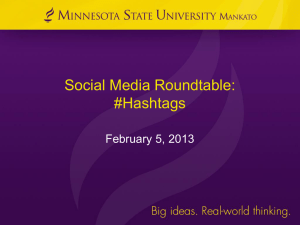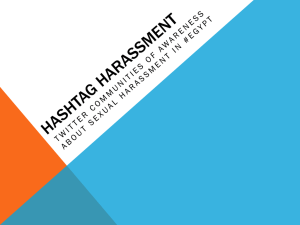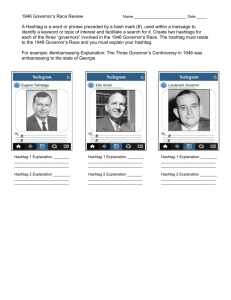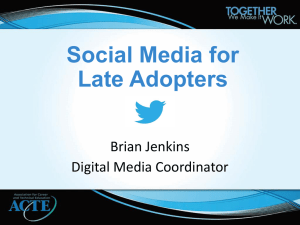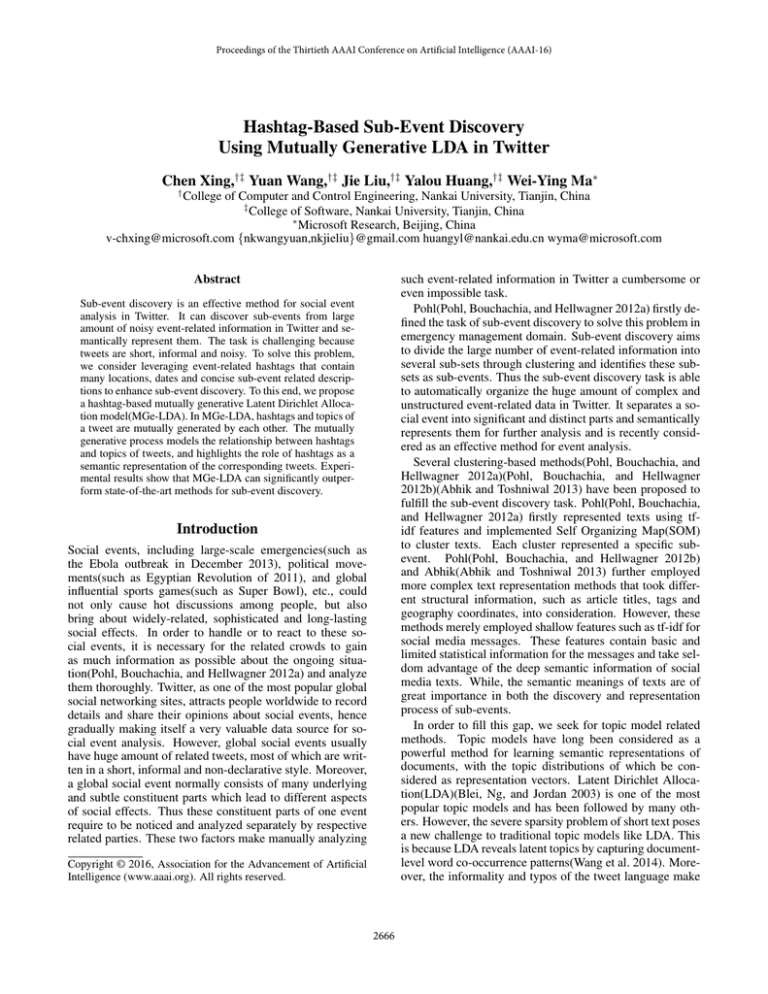
Proceedings of the Thirtieth AAAI Conference on Artificial Intelligence (AAAI-16)
Hashtag-Based Sub-Event Discovery
Using Mutually Generative LDA in Twitter
Chen Xing,†‡ Yuan Wang,†‡ Jie Liu,†‡ Yalou Huang,†‡ Wei-Ying Ma∗
†
College of Computer and Control Engineering, Nankai University, Tianjin, China
‡
College of Software, Nankai University, Tianjin, China
∗
Microsoft Research, Beijing, China
v-chxing@microsoft.com {nkwangyuan,nkjieliu}@gmail.com huangyl@nankai.edu.cn wyma@microsoft.com
such event-related information in Twitter a cumbersome or
even impossible task.
Pohl(Pohl, Bouchachia, and Hellwagner 2012a) firstly defined the task of sub-event discovery to solve this problem in
emergency management domain. Sub-event discovery aims
to divide the large number of event-related information into
several sub-sets through clustering and identifies these subsets as sub-events. Thus the sub-event discovery task is able
to automatically organize the huge amount of complex and
unstructured event-related data in Twitter. It separates a social event into significant and distinct parts and semantically
represents them for further analysis and is recently considered as an effective method for event analysis.
Several clustering-based methods(Pohl, Bouchachia, and
Hellwagner 2012a)(Pohl, Bouchachia, and Hellwagner
2012b)(Abhik and Toshniwal 2013) have been proposed to
fulfill the sub-event discovery task. Pohl(Pohl, Bouchachia,
and Hellwagner 2012a) firstly represented texts using tfidf features and implemented Self Organizing Map(SOM)
to cluster texts. Each cluster represented a specific subevent. Pohl(Pohl, Bouchachia, and Hellwagner 2012b)
and Abhik(Abhik and Toshniwal 2013) further employed
more complex text representation methods that took different structural information, such as article titles, tags and
geography coordinates, into consideration. However, these
methods merely employed shallow features such as tf-idf for
social media messages. These features contain basic and
limited statistical information for the messages and take seldom advantage of the deep semantic information of social
media texts. While, the semantic meanings of texts are of
great importance in both the discovery and representation
process of sub-events.
In order to fill this gap, we seek for topic model related
methods. Topic models have long been considered as a
powerful method for learning semantic representations of
documents, with the topic distributions of which be considered as representation vectors. Latent Dirichlet Allocation(LDA)(Blei, Ng, and Jordan 2003) is one of the most
popular topic models and has been followed by many others. However, the severe sparsity problem of short text poses
a new challenge to traditional topic models like LDA. This
is because LDA reveals latent topics by capturing documentlevel word co-occurrence patterns(Wang et al. 2014). Moreover, the informality and typos of the tweet language make
Abstract
Sub-event discovery is an effective method for social event
analysis in Twitter. It can discover sub-events from large
amount of noisy event-related information in Twitter and semantically represent them. The task is challenging because
tweets are short, informal and noisy. To solve this problem,
we consider leveraging event-related hashtags that contain
many locations, dates and concise sub-event related descriptions to enhance sub-event discovery. To this end, we propose
a hashtag-based mutually generative Latent Dirichlet Allocation model(MGe-LDA). In MGe-LDA, hashtags and topics of
a tweet are mutually generated by each other. The mutually
generative process models the relationship between hashtags
and topics of tweets, and highlights the role of hashtags as a
semantic representation of the corresponding tweets. Experimental results show that MGe-LDA can significantly outperform state-of-the-art methods for sub-event discovery.
Introduction
Social events, including large-scale emergencies(such as
the Ebola outbreak in December 2013), political movements(such as Egyptian Revolution of 2011), and global
influential sports games(such as Super Bowl), etc., could
not only cause hot discussions among people, but also
bring about widely-related, sophisticated and long-lasting
social effects. In order to handle or to react to these social events, it is necessary for the related crowds to gain
as much information as possible about the ongoing situation(Pohl, Bouchachia, and Hellwagner 2012a) and analyze
them thoroughly. Twitter, as one of the most popular global
social networking sites, attracts people worldwide to record
details and share their opinions about social events, hence
gradually making itself a very valuable data source for social event analysis. However, global social events usually
have huge amount of related tweets, most of which are written in a short, informal and non-declarative style. Moreover,
a global social event normally consists of many underlying
and subtle constituent parts which lead to different aspects
of social effects. Thus these constituent parts of one event
require to be noticed and analyzed separately by respective
related parties. These two factors make manually analyzing
Copyright © 2016, Association for the Advancement of Artificial
Intelligence (www.aaai.org). All rights reserved.
2666
it even harder for traditional topic models to capture the semantic information of tweet data.
Fortunately, we find that hashtags in Twitter can give
some help to leverage the two challenges for traditional topic
models mentioned above. In tweet data, hashtags which
are usually added by users to highlight topics or categorize
messages(Wang et al. 2014), contain many locations and
short event descriptions related to sub-events. For example, among the tweets for egypt revolution, most of tweets
tagged “suez” are about the arrest of activists in Suez city
and tweets with “humanrights” are about the protesters’ specific activities to fight for human rights. Hence, hashtags
can be viewed as a strong and concise semantic sign that
could help traditional topic models to discover sub-events
on semantic level. What’s more, one hashtag normally tags
multiple tweets. It indicates that hashtags can be used to reorganize and lengthen tweet texts. Thus this gives us a way
to leverage the sparsity problem. Therefore, hashtags can
not only be utilized to alleviate the sparsity of tweet data
in sub-event discovery task, but also a strong semantic sign
for sub-events that can help to overcome the informality and
noise of tweet texts.
According to the facts mentioned above, we propose
an extension of traiditional LDA, the mutually generative
LDA model(MGe-LDA), which employs hashtag information during the generative process to help discover subevents from a event-related tweet corpus. MGe-LDA is a
generative topic model that could capture the semantic information of both tweet texts and hashtags, and learns the topic
distributions of them. We then apply a clustering method on
hashtags’ topic representations learnt by MGe-LDA, to discover and represent sub-events. Compared to LDA, MGeLDA adds a hashtag generation layer and models hashtags as
distributions of topics. Moreover, MGe-LDA makes hashtags and topics of one tweet to be mutually generated. This
process emphasizes hashtags’ representativeness for the semantic meanings(topics) of tweet texts. It fits the fact that
most of hashtags in event-related data sets act as representative factors of sub-events. Furthermore, to leverage the typos
and repetitions in hashtags, we apply a hashtag graph for the
hashtag assignment process of MGe-LDA. In this modification, we include the hashtags in the graph which is highlysimilar to hashtags tagged in a tweet as assigning candidates
for the tweet. This modification leverages the noise and informality problem of tweet data one step further and ensures
the quality of topic distributions of both popular and rare
hashtags.
be classified as anomaly detection based approaches. They
focus on detecting abnormal features, such as word/hashtag
appearance or the number of messages published in a specific location, to monitor anomaly and represent new events.
Fung and Yu(Fung et al. 2005) firstly proposed a parameterfree method to detect bursty words and entities in text
streams, then detected events through clustering the detected
words and entities. Similarly, EDCoW(Weng and Lee 2011)
and Twevent(Li, Sun, and Datta 2012) are also based on
word burst detection. Specifically, in order to deal with the
short and noisy contents of tweets, Twevent(Li, Sun, and
Datta 2012) split each tweet into non-overlapping segments
then detected and clustered bursty segments to fulfill event
detection. Besides texts, structural information is also utilized for event detection. Several works(Watanabe et al.
2011)(Chen and Neill 2014) utilized hashtags and geotags
of social media data separately to detect bursts. Becker and
Naanman(Becker, Naaman, and Gravano 2011) extracted
temporal, social and topical features of message clusters in
order to classify them as event or non-event clusters. Each
of the clusters that was classified as event clusters represented one single detected event. Moreover, Aggarwal and
Subbian(Aggarwal and Subbian 2012) implemented similar
clustering method to group not only texts but also structural
information of social media streams. Afterwards, they generated alarms to call attention to newly emerged events when
the element-adding behavior of a particular cluster became
abnormally frequent.
Comparing to event detection, sub-event discovery hasn’t
drawn enough attention it deserves. Pohl(Pohl, Bouchachia,
and Hellwagner 2012a) firstly proposed a novel approach for
sub-event detection in emergency management. Pohl represented texts using tf-idf features and implemented Self Organizing Map(SOM) to cluster texts. Each cluster in the result
represented a specific sub-event. Furthermore, Pohl(Pohl,
Bouchachia, and Hellwagner 2012b) and Abhik(Abhik and
Toshniwal 2013) further applied two-phase clustering approaches that took structural information into consideration. In (Pohl, Bouchachia, and Hellwagner 2012b), the
first phase of clustering used geo-referenced data to locate
a sub-event, while the second phase used texts to describe
sub-events. Thus these existing methods employed little semantic analysis of texts during detection.
Modifications of LDA by adding layers. Latent Dirichlet Allocation(LDA) has long been proved a very effective
text understanding model. Many modifications of LDA have
been proposed to fulfill various text-related tasks such as text
mining and sentimental analysis. Rosen-Zvi and Griffiths
introduced the Author Topic model(Rosen-Zvi et al. 2004),
which is an extension of LDA to involve authorship information and then model the interests of authors. In Author
Topic model, each author is associated with a distribution
over topics and each topic is associated with a distribution
over words. While it assumed that the author distribution of
each document is uniform. HGTM(Wang et al. 2014) extended ATM to make it fit the characteristics of tweet data.
HGTM treats hashtags in tweet data as authors and added
a hashtag graph to leverage the sparsity problem of short
tweet texts. Similarly, Lin and He(Lin and He 2009) in-
Related Work
In this section, we first give a brief overview of the studies on
event/sub-event detection using social media data. Secondly,
for semantic analysis, we survey the specific modification of
LDA which add layers to involve factors like hashtags or
authors in the generative model besides topics and words.
Event/sub-event detection using social media data.
Event detection, which has drawn many interests in recent
years, is a similar task to sub-event discovery and could offer
some insights for the data representation during sub-event
discovery. Most existing approaches of event detection can
2667
Figure 1: (a) Latent Dirichlet Allocation(LDA). (b) Muatually Generative LDA(MGe-LDA).
tive process is as follows.
troduced joint sentiment/topic model(JST) for unsupervised
sentimental analysis and opinion mining. JST added a sentiment label layer in front of the topic layer and assumed the
sentiment distribution of each document is multinomial.
In this paper, MGe-LDA adds a hashtag generation layer
to involve hashtags in generative process of a tweet corpus and models hashtags as distributions of topics. What’s
more, unlike other modifications of LDA that also add layers before the topic layer and model a one-way generation
from the added layer to the topic layer, MGe-LDA makes
hashtags and topics of one tweet to be mutually generated.
More specifically, the model prefers generating hashtags
with higher similarity in topic distributions to the tweet. This
process emphasizes hashtags’ representativeness for the semantic meanings of tweet texts. It fits the fact that most of
hashtags in event-related data sets act as representative factors of sub-events such as locations and short descriptions.
The high-quality hashtag topic distributions produced by the
mutually generative process benefit both the discovery and
representing process for sub-event discovery.
θ ∼ Dirichlet(α)
φ ∼ Dirichlet(β)
zdi |θd ∼ M ultinomial(θd )
wdi |φzdi ∼ M ultinomial(φzdi )
In order to model the generative process of tweets with
hashtags, we propose a hashtag-based mutually generative
LDA(MGe-LDA) model which adds a hashtag layer between the document and topic layer and lets hashtags and
topics of one tweet mutually generate each other. The
graphic model of MGe-LDA is represented as Figure 1(b).
In MGe-LDA, each hashtag is associated with a multinomial distribution over topics and each topic is represented
as a multinomial distribution over words. Different from
LDA, the generation of one tweet includes not only generating the word sequence but also the hashtag sequence belonging to this tweet. Let sd = {sd1 , sd2 , ..., sdNd } and
zd = {zd1 , zd2 , ..., zdNd } represent the hashtag and topic
assignments separately for the word sequence of tweet d.
Note that the distinct members of sdi form the hashtag sequence hd of tweet d. Words of a tweet are generated in sequence. For word wdi in tweet d, one firstly chooses a hashtag sdi according to the P (h|zh ), where zh represents the
topic assignments for the word sequence of hashtag h. This
is because intuitively, the choice of hashtags when we pose
tweets is tightly related to their topic distributions and the
current topic assignments of hashtags directly reflect their
topic distributions. Thus refereing to the topic assignments
of hashtags gives a wiser choice of hashtags related to tweet
texts. Then, one chooses a topic zdi with respect to the topic
distribution of sdi , θsdi . Following this, wdi is chosen according to the word distribution φzdi , which is the same as
the last generating step of LDA. Through this process both
the hashtag sequence hd and word sequence wd of tweet d
are generated. Thus the formal description of MGe-LDA’s
generating process is as follows,
Hashtag-based Mutually generative LDA
We define the tweet corpus as C = {d1 , d2 , ..., dD }; each
document d in this corpus is composed of a word sequence
wd = {wd1 , wd2 , ..., wdNd } and a hashtag sequence hd =
{hd1 , hd2 , ..., hdHd }. Note that the lengths of the hashtag
sequence and the word sequence are different. Each word in
documents is an item from the corpus vocabulary with the
size of V. Also, let H be the total number of distinct hashtags in the corpus and T be the number of topics. Traditional LDA models document d as merely a word sequence
wd . In LDA, documents are modeled as mixtures of topics and every topic is represented as a multinomial distribution over words. The generative process of a document d
in LDA is divided into three steps as illustrated in Figure
1(a). First, one chooses a multinomial topic distribution θ
for document d under the Dirichlet prior with parameter α.
Then, for the ith word wdi in wd , one chooses a topic zdi
according to multinomial topic distribution θ; finally, the ith
word wdi is generated according to topic zdi ’s word distribution Φ (which is also multinomial under a Dirichlet prior
with parameter β). The general description of this genera-
• For each hashtag h, choose a topic distribution θh ∼
Dirichlet(α);
• For each topic t, choose a word distribution φt ∼
Dirichlet(β);
2668
where γj is the appearance frequency of hashtag j in the
whole corpus. Moreover, it should be noted that during
the sampling of sdi , we don’t have to traverse all hashtags
in hashtag list of the corpus since we’ve known the hashtag sequence hd for tweet d. We only need to calculate all
p(sdi = j|s−di , z) when hashtag j belongs to hd .
After iterative sampling, the algorithm reaches its convergence. The final result of θ and φ are,
• For each tweet d in the corpus,
– For each word wdi in tweet d,
– choose a hashtag sdi ∼ P (h|zh );
– choose a topic zdi ∼ θsdi ;
– choose a word wdi ∼ φzdi
where P (h|zh ) ∝ P (h) · P (zh |h). P (h) can be defined as
a multinomial distribution γ that γh is the appearance frequency of hashtag h in the whole corpus. zh is the current
topic assignments for the word sequence of hashtag h. The
first state of these topic assignments is randomly initialized.
In order to get the topic distributions of hashtags and mine
semantic information from event-related tweets, we need to
infer the latent variables θ and φ. Let w denotes the whole
word sequence of the entire corpus and z, s denotes the topic
and hashtag assignments for w separately. To infer θ and φ,
we firstly estimate the posterior probability of z. By integrating out θ we can get,
H
TH
Γ(T α) H j Γ(Cjh + α)
p(z|s) = (
(1)
)
(Γ(α))T
Γ( j CjT hH + T α)
h=1
φt ∝ In this section we make a modification for MGe-LDA by
applying a hashtag graph for the hashtag assignment process. This hashtag graph models the similarity and relation of all hashtags in the event-related tweet corpus. As
illustrated above, in MGe-LDA, the hashtag candidates for
hashtag assignments of tweet d are only those in the hashtag sequence hd . In this modification, we tend to loosen this
limitation by including hashtags highly-related to those in
the hashtag sequence hd as candidates. The reason of this
is that there are many typos and extremely similar hashtags
in the whole tweet dataset since most of hashtags are added
manually by users. For example, hashtag ”jna25” is a typo
of hashtag ”jan25”, and ”jan25”, ”egypt” are both representing the Egypt revolution at Jan 25th in our data set. Thus
even though these hashtags do not belong to the hashtag sequence of tweet d, they are reasonable candidates of hashtag
assignments for the current tweet. Therefore, this modification leverages the noise and informality problem of tweet
data one step further and ensures the quality of topic distributions of both popular and rare hashtags.
We take G = (V, E) to represent the hashtag graph, the
nodes V = {h1 , h2 , ..., hH } in which are hashtags and each
eij in E = {(eij )}i,j∈V,i=j represents the number of times
hashtag i and j have been added with the same tweets since
appearing in the same tweets is a strong sign of semantic
similarity for two hashtags. We introduce τ to represent the
probability that we have to choose a hashtag in the graph.
Thus the hashtag assigning process for every word wdi of
MGe-LDA with graph can be divided into three sub-steps,
(3)
Gibbs Sampling will sample every element zdi in z from the
popularity of topics given the status of all other elements
in z. The probability that topic t is assigned to zdi can be
calculated as follows,
·
WT
+β
Cwt,−di
(4)
where h is the hashtag assignment of wdi . Obviously, the
assignment process of z relies on s, the hashtag assignment
sequence of w. Thus next we discuss about the sampling
process of s.
According to the generative process of MGe-LDA, the
posterior popularity of s is,
P (s|z) ∝ P (z, s) = P (z|s) · P (s)
(5)
We have calculated P (z|s) in equation (1). Thus the probability of hashtag j assigned to hwdi that is required in Gibbs
Sampling is as follows,
p(sdi = j|s−di , z) ∝ γj · TH
+α
Cth,−di
t
H
CtT h,−di
+ Tα
(8)
Table 1: Statistical information of 3 event data sets extracted
from TREC 2011
Name
#tweets
Vocabulary #hashtags
size
ER
6628
4433
1200
SB
2948
3104
614
SOTU
1840
2636
389
WT
where Cwt
is the number of times that word w is assigned
to topic t. Then we could use Gibbs Sampling(Griffiths and
Steyvers 2004) to construct z according to,
WT
w Cw t,−di + W β
CT H + α
th,−di
TH
t Ct h,−di + T α
WT
+β
Cwt
.
WT + Wβ
C
w w t
MGe-LDA with hashtag graphs
is the number of times that topic j has been
where
assigned to words whose hashtag assignment is hashtag h.
Next, by integrating out φ we could get,
T
WT
Γ(W β) T w Γ(Cwt + β)
p(w|z) = (
(2)
)
W T + W β)
(Γ(β))W t=1 Γ( w Cw
t
p(zdi = t|z−di , w, s) ∝ (7)
The hashtag-topic distributions θ are implemented as features for clustering in the sub-event detection task.
TH
Cjh
P (z|w, s) ∝ P (z, w|s) = P (z|s)P (w|z)
TH
+α
Cth
T
H
t C t h + T α
θh ∝ (6)
1. sample a hashtag t from hd according to equation (6);
2669
2. sample r, r ∼ Bernoulli(τ );
H-score of sub-event discovery
3. if r = 0, wdi ’s hashtag assignment sdi =t; else sample sdi
from gt according to equation(6).
We firstly measure the sub-event discovery result with Hscore(Yan et al. 2013), which is the ratio of the average
intra-cluster distance and the average inter-cluster distance
of hashtag clustering results. The average inter-cluster distance can be calculated as follows,
where gt is the set of hashtags that have direct edges to hashtag t.
IntraDis (C) =
Experimental Analysis
K
1 [
K
k=1 hi ,hj ∈Ck ,i=j
2dis(hi , hj )
]
Ck Ck − 1
(9)
where dis(hi , hj ) represents the cosine-similarity of
hashtag i and j and Ck represents the number of hashtags allocated to the kth cluster. The average inter-cluster
distance is:
InterDis (C) =
2dis(hi , hj )
1
]
[
K(K − 1)
Ck Ck In this section, we conduct sub-event discovery experiments
on Twitter data to verify the effectiveness of MGe-LDA.
The experiment procedures are as follows. After running
MGe-LDA on an event-related tweet data set, we could get
the topic distributions of hashtags in the data set. In our
sub-event discovery experiment, we run K-means(Hartigan
and Wong 1979) to cluster hashtags in their topic space,
which takes hashtags’ topic distributions as their feature vectors. The distance between two objects is measured by their
cosine-similarity. To evaluate the sub-event discovery result,
we use the H-score(Yan et al. 2013) of clustering results to
evaluate the semantic compaction of one sub-event and the
semantic distinction among all detected sub-events. What’s
more, we take top n hashtags nearest to the cluster centroids
to represent discovered sub-events and analyze the semantic
meanings of them.
We compare MGe-LDA and MGe-LDA with hashtag
graphs with four other models: 1) tf-idf+SOM model(Pohl,
Bouchachia, and Hellwagner 2012a), which builds tf-idf features for tweet texts and clusters them using Self Organizing Map(SOM); 2)LDA(Blei, Ng, and Jordan 2003), Latent
Dirichlet Allocation, which takes each tweet as a document;
3)ATM(Rosen-Zvi et al. 2004), the Author Topic Model
that we replace ”author” as ”hashtag” in our experiment;
4)HGTM(Wang et al. 2014), the hashtag graph topic model,
which is an extension of ATM that implements related hashtags in hashtag graphs to leverage sparsity of tweet data. It
should also be noted that since traditional LDA and tf-idf
don’t model the generation of hashtags in them, we aggregate all tweets tagged by the same hashtag to construct a
pseudo hashtag document to infer the hashtag’s topic distribution.
In our experiments, we set the number of topics T as 5
and the number of clusters K as 5. The hyperparameter β of
all topic models is set as 0.01. As for the hyperparameter α
and τ in topic models related to the hashtag graph, we tune
them separately for each model to get its best performance.
Ck ,Ck ∈C,k=k hi ∈Ck hj ∈Ck
(10)
Thus the H-score of the clustering result is as follows,
IntraDis(C)
(11)
InterDis(C)
Since we cluster hashtags with their topic distributions as
feature vectors, H-score of the clustering result measures the
spatial distributions of sub-events in their topic space. From
the equations above, we can easily see that smaller intracluster distances and larger inter-cluster distances result in a
lower H-score. A lower H-score indicates that hashtags allocated to one sub-event are more semantically related and
hashtags belonging to different sub-events are more semantically distinct. A decent H-score means that discovered subevents are topically focused and independent. The H-scores
for sub-event discovery in the 3 data sets are shown in Table
3.
From the H-score results, we could get the following conclusions. Firstly, all the topic model based methods, including MGe-LDA and MGe-LDA with hashtag graphs we proposed in this paper, outperform the current sub-event discovery method, tf-idf+SOM a great deal(with p-value¿0.6) on
all the 3 event data sets. This proves that introducing topic
model based methods benefits the sub-event discovery task
a lot since topic models can better capture the semantic information embedded in tweet texts, which is a deeper level
of hints that could help us splitting sub-events. Secondly,
among all topic model based methods, MGe-LDA and MGeLDA with hashtag graphs achieve the best performance on
all the 3 events. This indicates that MGe-LDA methods(with
and without hashtag graphs) produces more similar hashtag
topic distributions for semantically similar hashtags and vice
verse. In other words, hashtags form more clear clusters in
their topical space. This is because in the generative process
of MGe-LDA, we generate hashtags of a tweet according to
the topic distribution of this tweet. Therefore, the tweet’s
topic distribution acts as a bridge for hashtags belonging to
this tweet, or can be viewed as weak supervision information for hashtag assignment during the parameter estimation
process.
H=
Data Sets
We build three event data sets from the TREC 2011 microblog data set. It contains nearly 16 million tweets sampling from January 23rd to February 8th, 2011. There are
three major events happening in this period which bring
about heated discussions on Twitter, the Egyptian Revolution of 2011, Super Bowl 2011 and 2011 State of the Union
Address. Thus we manually select tweets related to these
three events separately and form three event data sets represented as ER, SB and SOTU.
2670
Table 2: Semantic representations of sub-events of ER
1
breakingnews
cnn
egyptians
revolution
jan28
p2
cairo
tahrir
jan25
egypt
MGe-LDA with graph
2
3
4
humanrights google
socialmedia
teaparty
tahrirsquare islam
wikileaks
aje
fb
democracy
elbaradei
australia
egipto
freeayman syria
usa
suez
censorship
news
alexandria twitter
feb1
sidibouzid uk
obama
aljazeera
yemen
mubarak
25jan
israel
5
palestine
lebanon
us
jordan
freedom
protest
iranelection
iran
tcot
tunisia
1
feb01
freeegypt
world
justsaying
hosnimub
alarabiya
amman
london
jan26
ff
2
freesherinet
europe
26jan
datalove
chaos
wef
anonops
feb4
freeayman
uk
HGTM
3
jan28
p2
tcot
25jan
tunisia
cairo
tahrir
mubarak
jan25
egypt
4
live
blair
respect
abc
ac360
tweet
tunisie
foxnews
jan
australia
5
iraq
hamradio
pakistan
haiti
media
fok
tunis
teargas
arab
aje
2 is about uncovering the deep reason for this revolution
since the hashtag list contains the main general goal of
this fight(“humanrights”, “democracy”) and the major suspected back-stage planner(“wikileaks”, “usa”, “obama”).
As for sub-event 3, the representative hashtag list indicates that it is about the arrest of activists(mainly happened in “suez” and “alexandria”), especially the arrest of
Al Jazeera English’s(“aje”, “aljazeera”) journalists such as
Ayman Mohyeldin(“freeayman”). Sub-event 4 is about the
internet black out of Egypt and Syria(“syria”) ordered by
their governments’ ”censorship” in Jan 27th and the whole
Egypt almost disappeared in most of popular “socialmedia”
sites(“fb”, “twitter”). The final sub-event is also quite clear
according to its representative hashtag list. The list contains
many countries affected by the Arab Spring such as “palestine”, “lebanon”, “jordan” and “iran”, which indicates that
this sub-event is mainly about the revolution’s influence on
other Arabian countries. In sum, the representative hashtag lists of sub-events extracted by MGe-LDA with graph is
very semantically concentrated and explicit, which benefit
the analysis of sub-events they represent.
As for other models, unlike MGe-LDA with hashtag
graph, their results don’t have obvious semantic focus for every sub-event. As shown in Table 3, the hashtag lists without
black boxes are those that cannot be concluded a general description for their correspondent sub-events. Except MGeLDA with graph, MGe-LDA performs the best and extracts
four focused hashtag lists.
Table 3: H-Scores of sub-event discovery for the 3 events
Data set
Model
H-score
tf-idf+SOM
0.9604
LDA
0.1468
ATM
0.1598
ER
HGTM
0.1389
MGe-LDA
0.0774
MGe-LDA with graph 0.0232
tf-idf+SOM
0.9549
LDA
0.1314
ATM
0.3067
SB
HGTM
0.1329
MGe-LDA
0.0813
MGe-LDA with graph 0.0364
tf-idf+SOM
0.9063
LDA
0.1318
ATM
0.0968
SOTU
HGTM
0.1526
MGe-LDA
0.0846
MGe-LDA with graph 0.0124
Semantic representations of sub-events
After the discovery of sub-events, we ought to figure out
what the sub-events we discovered are about because the
goal of this task is to understand the whole event in a finergrained way. In this section, we choose n hashtags that are
most popular in the cluster to semantically represent the subevent. The semantic representations of sub-events of Egyptian Revolution 2011(ER) extracted by different models are
shown in Table 2.
In Table 2, we list top ten most popular hashtags in
the clusters separately to represent each of the five subevents we discovered. Hashtags in black boxes are those
who give clear clues about the contents of the sub-events
they belong to. The result of MGe-LDA with hashtag
graph gives the most explicable and rational representations for sub-events. From the representative hashtags
for sub-event 1, we can easily tell that sub-event 1 our
model discovered is about the protesters’ occupation of the
Tahrir Square during the first several days of the revolution.
Representative hashtags gives clear time(“jan25”, “jan28”),
location(“tahrir”, “cario”, “egypt”) and the progressiveness(“breakingnews”, “p2”) for this movement. Sub-event
Conclusion and Future Work
In this paper, we focused on extending topic models for subevent discovery in Twitter. We applied event-related hashtags in MGe-LDA model to capture semantic information
from the short, informal and noisy tweet data. Moreover, to
leverage the typos and repetitions in hashtags, we applied a
hashtag graph for the hashtag assignment process of MGeLDA. The hashtag graph benefits MGe-LDA in considering
typos and repetition of hashtags in tweets, and then helps
topic representation learning. In future work of this paper,
except for hashtags, we hope to make use of other structural
information such as geography coordinates, users’ relationship and time series information in Twitter. Even though
geography information is relatively rare, intuitively we suppose it can benefit sub-event discovery task very much since
it is a significant attribute for sub-events.
2671
References
geolocation information propagated to microblogs. In Proceedings of the 20th ACM international conference on Information and knowledge management, 2541–2544. ACM.
Weng, J., and Lee, B.-S. 2011. Event detection in twitter.
ICWSM 11:401–408.
Yan, X.; Guo, J.; Lan, Y.; and Cheng, X. 2013. A biterm
topic model for short texts. In Proceedings of the 22nd international conference on World Wide Web, 1445–1456. International World Wide Web Conferences Steering Committee.
Abhik, D., and Toshniwal, D. 2013. Sub-event detection
during natural hazards using features of social media data. In
Proceedings of the 22nd international conference on World
Wide Web companion, 783–788. International World Wide
Web Conferences Steering Committee.
Aggarwal, C. C., and Subbian, K. 2012. Event detection in
social streams. In SDM, volume 12, 624–635. SIAM.
Becker, H.; Naaman, M.; and Gravano, L. 2011. Beyond
trending topics: Real-world event identification on twitter.
ICWSM 11:438–441.
Blei, D. M.; Ng, A. Y.; and Jordan, M. I. 2003. Latent
dirichlet allocation. the Journal of machine Learning research 3:993–1022.
Chen, F., and Neill, D. B. 2014. Non-parametric scan statistics for event detection and forecasting in heterogeneous social media graphs. In Proceedings of the 20th ACM SIGKDD
international conference on Knowledge discovery and data
mining, 1166–1175. ACM.
Fung, G. P. C.; Yu, J. X.; Yu, P. S.; and Lu, H. 2005. Parameter free bursty events detection in text streams. In Proceedings of the 31st international conference on Very large data
bases, 181–192. VLDB Endowment.
Griffiths, T. L., and Steyvers, M. 2004. Finding scientific
topics. Proceedings of the National Academy of Sciences
101(suppl 1):5228–5235.
Hartigan, J. A., and Wong, M. A. 1979. Algorithm as 136:
A k-means clustering algorithm. Applied statistics 100–108.
Li, C.; Sun, A.; and Datta, A. 2012. Twevent: segmentbased event detection from tweets. In Proceedings of
the 21st ACM international conference on Information and
knowledge management, 155–164. ACM.
Lin, C., and He, Y. 2009. Joint sentiment/topic model for
sentiment analysis. In Proceedings of the 18th ACM conference on Information and knowledge management, 375–384.
ACM.
Pohl, D.; Bouchachia, A.; and Hellwagner, H. 2012a. Automatic sub-event detection in emergency management using
social media. In Proceedings of the 21st international conference companion on World Wide Web, 683–686. ACM.
Pohl, D.; Bouchachia, A.; and Hellwagner, H. 2012b. Supporting crisis management via sub-event detection in social
networks. In Enabling Technologies: Infrastructure for Collaborative Enterprises (WETICE), 2012 IEEE 21st International Workshop on, 373–378. IEEE.
Rosen-Zvi, M.; Griffiths, T.; Steyvers, M.; and Smyth, P.
2004. The author-topic model for authors and documents.
In Proceedings of the 20th conference on Uncertainty in artificial intelligence, 487–494. AUAI Press.
Wang, Y.; Liu, J.; Qu, J.; Huang, Y.; Chen, J.; and Feng, X.
2014. Hashtag graph based topic model for tweet mining. In
Data Mining (ICDM), 2014 IEEE International Conference
on, 1025–1030.
Watanabe, K.; Ochi, M.; Okabe, M.; and Onai, R. 2011.
Jasmine: a real-time local-event detection system based on
2672

